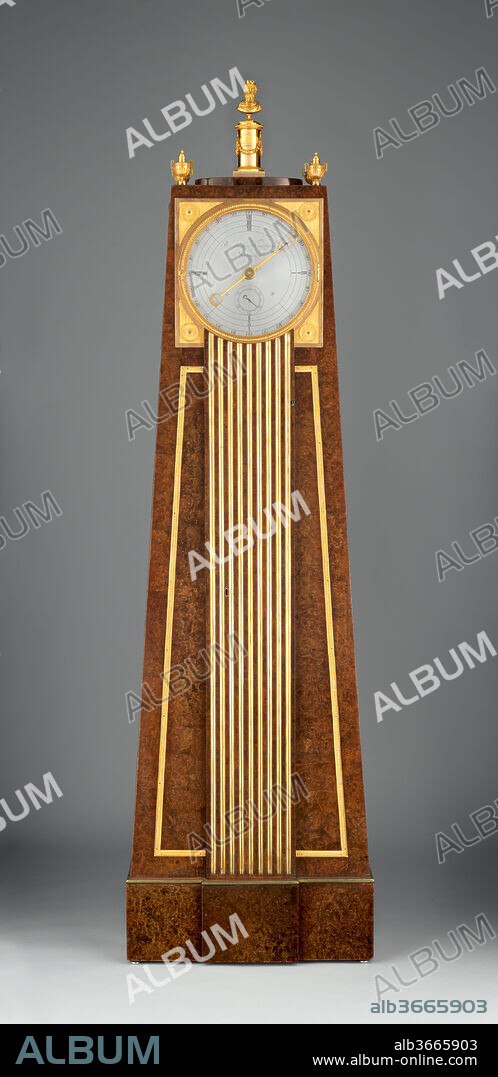alb3665903
CLOCKMAKER: PETER KINZING. Obelisk clock with a Franklin movement

|
Add to another lightbox |
|
Add to another lightbox |



Title:
Obelisk clock with a Franklin movement
Caption:
Obelisk clock with a Franklin movement. Artist: Clockmaker: Peter Kinzing (German, 1745-1816). Culture: German, Neuwied am Rhein. Dimensions: Overall: 75 × 21 1/8 × 7 5/8 in. (190.5 × 53.7 × 19.3 cm). Maker: Case maker: David Roentgen (German, Herrnhaag 1743-1807 Wiesbaden, master 1780). Date: ca. 1785-90.
The unusual obelisk shape of this case accommodates the swing of the pendulum and reflects the new taste for ancient Egyptian art, or "Egyptomania," in Europe at the time. The finial at the top of the clock is, fittingly, in the form of the double-faced head of Janus, the Roman god of beginnings and endings. The simplified movement--consisting of just three wheels, a four-hour spiral-ring dial, and a single minute hand--was invented by Benjamin Franklin in the 1760s or 1770s. Franklin may have come in contact with cabinetmaker David Roentgen and clockmaker Peter Kinzing while in Paris. Kinzing improved upon Franklin's original model: the addition of a small pointer, seen through an aperture in the minute hand, allowed for a clearer determination of the correct hour. Though Franklin intended for his simplified movement to be used in economically produced clocks, here it has been employed for one of the most luxurious. The dial is made of solid silver--an extremely rare and expensive feature for any clock.
Technique/material:
Oak, thuya burl wood, gilded bronze, silver, and steel
Museum:
Metropolitan Museum of Art, New York, USA
Maker:
Case maker: David Roentgen (German, Herrnhaag 1743-1807 Wiesbaden, master 1780)
Credit:
Album / Metropolitan Museum of Art, NY
Releases:
Model: No - Property: No
Rights questions?
Rights questions?
Image size:
2336 x 4800 px | 32.1 MB
Print size:
19.8 x 40.6 cm | 7.8 x 16.0 in (300 dpi)
Keywords:
ARTFORM: BRONZEWORK • BRONCE • BRONZE BRASS • BRONZE • BRONZES • BURL VENEER • CASE MAKER: DAVID ROENTGEN (GERMAN, HERRNHAAG 1743-1807 WIESBADEN, MASTER 1780) • CLOCKMAKER: PETER KINZING • CLOCKS • COPPER ALLOY • ENCINA • EUROPE • EUROPEAN SCULPTURE AND DECORATIVE ARTS • FURNITURE • GERMANY • GILT • IRON ALLOY • IRON AND IRON ALLOY • IRON AND STEEL • IRON_AND_STEEL • METAL • METROPOLITAN MUSEUM OF ART, NEW YORK, USA • OAK • OAK, THUYA BURL WOOD, GILDED BRONZE, SILVER, AND STEEL • SILVER • STEEL INDUSTRY • STEEL • TIMEPIECES • VENEER • WOOD • WOODWORK
 Pinterest
Pinterest Twitter
Twitter Facebook
Facebook Copy link
Copy link Email
Email

